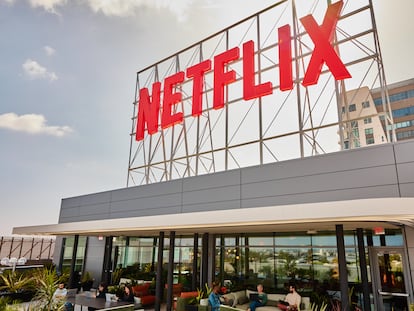Streaming platforms navigate user disloyalty
Too much content, high prices and time constraints drive an endless cycle of customer subscriptions and quick cancellations

María Bielsa is 57 years old and watches a lot of TV series, but never on broadcast or cable television. She is a regular Movistar, Netflix, Prime Video and Filmin subscriber and signs up for other services if they have something specific she wants to watch. “I signed up for HBO Max to watch The Gilded Age, paid for a month and canceled before the automatic renewal kicked in. I did the same thing to watch The Bear [Hulu and Disney+].” Ainhoa Gorriz has subscribed and canceled Netflix several times to explore new content on platforms like Prime Video or her local library’s streaming video service. “In the end, I always go back to [Netflix] because it has the best stuff,” said the young woman in her twenties.
María and Ainhoa are just two examples of a common practice as video on demand services proliferate, requiring users to be more selective. Data reveals that growth, which surged over the years and spiked during the pandemic, has now slowed. More content and higher prices led to 10% subscription growth in the United States in 2023, down from 21.6% in 2022, according to Antenna’s February report. The study also highlights the rise of “resubscriptions” — where users cancel and then re-subscribe to a service a few months later.
Currently, more customers are canceling their payment platform subscriptions, but many are coming back. Ten percent of those who cancel will resubscribe the next month, 23% within three months, 37% within nine months, and 41% within a year. Antenna’s report also reveals that 23% of users who’ve signed up and canceled subscriptions have done so at least three times in the last two years. This percentage was 17% in 2022 and only 3% in 2019 when content supply and user numbers were lower. Forty-two percent have canceled more than five times in the last two years, with 19% doing so over seven times. Apple TV+ had the highest resubscription rate at 37.2%, while Netflix’s percentage dropped from 35.2% in 2022 to 26% in 2023 after it cracked down on account sharing.

Xavier Molina shares a Filmin account, has an annual HBO Max subscription, and hops around Netflix, Apple TV+ and Disney+ depending on what they offer. “Before I unsubscribe, I jot down the series that catch my eye so when I subscribe again, I don’t get overwhelmed by all the content. Right now, I have Disney. But once Shōgun ends, I’ll switch to Netflix to watch Ripley.” Carlos Sierra has an annual subscription to Prime Video and HBO Max. He also subscribes to Netflix, Disney+ and Filmin to watch specific movies of series, and then cancels when they’re over. He says he might try SkyShowtime soon. “That’s how I avoid spending too much. Not just because of the prices, but also because I can’t watch everything if I’m subscribed to all of them at the same time,” said Sierra. “I make lists of stuff I’m interested in watching, and then go straight there when I start a new monthly subscription.” Netflix is the service he goes back to most frequently.

In the U.S., Netflix has the lowest subscription cancellation rate, staying below 2%. The average cancellation rate in 2023 was 5.5%, up by 0.8 points from 2022.
In Spain, subscription cancellations are now outpacing registrations. The TV-OTT Barometer report by Barlovento Comunicación shows 18.68 million service registrations in 2023 versus 21.18 million cancellations, a drop of almost 2.5 million subscriptions. Netflix suffered the largest drop in subscribers, while Prime Video and Disney+ saw net gains in subscribers (as did SkyShowtime, which launched in 2023). The top reason Spaniards unsubscribe from a platform is price hikes, followed by decreased usage frequency. In a December 2023 Barlovento Comunicación survey, 41.2% of Netflix cancellations were due to shared account restrictions. Other reasons for cancelling a streaming subscription include a specific title offered elsewhere and the lack of appealing free TV options.
Data indicates it’s harder for platforms to retain subscriber loyalty. As streaming matures, they must shift focus to manage fluctuating subscribers effectively. “Retention isn’t just about retaining first-time subscribers. It’s also about nurturing a relationship throughout the customer’s life,” said Antenna CEO Jonathan Carson in a Wall Street Journal article. To achieve this, services are experimenting with discounted, ad-supported service tiers and bundling multiple services at reduced rates. All aimed at retaining increasingly disloyal customers.
Sign up for our weekly newsletter to get more English-language news coverage from EL PAÍS USA Edition
Tu suscripción se está usando en otro dispositivo
¿Quieres añadir otro usuario a tu suscripción?
Si continúas leyendo en este dispositivo, no se podrá leer en el otro.
FlechaTu suscripción se está usando en otro dispositivo y solo puedes acceder a EL PAÍS desde un dispositivo a la vez.
Si quieres compartir tu cuenta, cambia tu suscripción a la modalidad Premium, así podrás añadir otro usuario. Cada uno accederá con su propia cuenta de email, lo que os permitirá personalizar vuestra experiencia en EL PAÍS.
¿Tienes una suscripción de empresa? Accede aquí para contratar más cuentas.
En el caso de no saber quién está usando tu cuenta, te recomendamos cambiar tu contraseña aquí.
Si decides continuar compartiendo tu cuenta, este mensaje se mostrará en tu dispositivo y en el de la otra persona que está usando tu cuenta de forma indefinida, afectando a tu experiencia de lectura. Puedes consultar aquí los términos y condiciones de la suscripción digital.











































